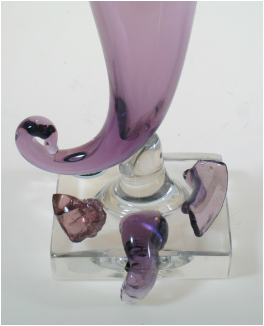
Once in a Blue Moon, or should I say "Lilac Moon," an example of Pairpoint glass appears that is lilac in color. Our first experience was with a lilac Cornucopia Vase with a square foot in clear. The style of the vase was true to the many other examples of the Cornucopia vases normally attributed to the Gundersen-era, but known to be made before 1938, as well.
At the recent Hoosier Glass Show, in Indianapolis, a dealer friend, Jim Watson, had for sale a beautiful A298 Urn Vase in this identical lilac color, a very confusing (or enlightening) occurrence. The A298 Urn Vase is not a commonly-seen item, and would typically not be attributed to any time period after the traditional Pairpoint-era that ended in 1938. Needless to say, there was a lot of commiserating and head-scratching among knowledgeable dealers and collectors about the Lilac Pairpoint vase in Jim Watson's booth, which certainly raised a legitimate question about the production of a lilac color by Pairpoint, the timing of the production, and whether it could be nothing more than a pale shade of the deep rich Amethyst color.
Remembering our stockpile of Pairpoint glass shards dug from the Pairpoint factory site in New Bedford in the early 1960s, before the big fire, Sandy and I dug through our stash this past weekend. Out of the 200-300 pounds of shards, we found only three pieces of Lilac, which we have photographed for this article. Since it was dug in the 60s, we can only speculate whether it came from the Pairpoint-era or the Gundersen-era, but we can say with a high degree of confidence that Pairpoint did make a Lilac color. Two remaining questions would be (1) is this Lilac color just a lighter shade of Amethyst, and (2) was it intentionally formulated? A close examination of the Lilac next to a similar thickness of conventional Amethyst does show a similar hue, leaning toward red versus blue on the color wheel. Secondly, the existence of more than one finished example from seemingly different time periods, and the presence (albeit sparse) of glass shards from the dig, would indicate the use of the Lilac color was intentional.
If the Lilac only showed-up as Cornucopia vases or only as A298 vases (typically expected to come from a few decades apart), we could speculate about the color being experimental, or special order, or short-lived. But as the examples have appeared, Lilac seems to have been made over a longer span of time, perhaps sporadically. If this would be true, why have other examples not turned-up more regularly, or perhaps they have and we haven't seen them.
If any of our readers have any information or other sightings of Lilac, please contact me at [email protected] or [email protected]. Photographs would be fantastic.
Marion Frost
2015-07-20.01
At the recent Hoosier Glass Show, in Indianapolis, a dealer friend, Jim Watson, had for sale a beautiful A298 Urn Vase in this identical lilac color, a very confusing (or enlightening) occurrence. The A298 Urn Vase is not a commonly-seen item, and would typically not be attributed to any time period after the traditional Pairpoint-era that ended in 1938. Needless to say, there was a lot of commiserating and head-scratching among knowledgeable dealers and collectors about the Lilac Pairpoint vase in Jim Watson's booth, which certainly raised a legitimate question about the production of a lilac color by Pairpoint, the timing of the production, and whether it could be nothing more than a pale shade of the deep rich Amethyst color.
Remembering our stockpile of Pairpoint glass shards dug from the Pairpoint factory site in New Bedford in the early 1960s, before the big fire, Sandy and I dug through our stash this past weekend. Out of the 200-300 pounds of shards, we found only three pieces of Lilac, which we have photographed for this article. Since it was dug in the 60s, we can only speculate whether it came from the Pairpoint-era or the Gundersen-era, but we can say with a high degree of confidence that Pairpoint did make a Lilac color. Two remaining questions would be (1) is this Lilac color just a lighter shade of Amethyst, and (2) was it intentionally formulated? A close examination of the Lilac next to a similar thickness of conventional Amethyst does show a similar hue, leaning toward red versus blue on the color wheel. Secondly, the existence of more than one finished example from seemingly different time periods, and the presence (albeit sparse) of glass shards from the dig, would indicate the use of the Lilac color was intentional.
If the Lilac only showed-up as Cornucopia vases or only as A298 vases (typically expected to come from a few decades apart), we could speculate about the color being experimental, or special order, or short-lived. But as the examples have appeared, Lilac seems to have been made over a longer span of time, perhaps sporadically. If this would be true, why have other examples not turned-up more regularly, or perhaps they have and we haven't seen them.
If any of our readers have any information or other sightings of Lilac, please contact me at [email protected] or [email protected]. Photographs would be fantastic.
Marion Frost
2015-07-20.01
 RSS Feed
RSS Feed